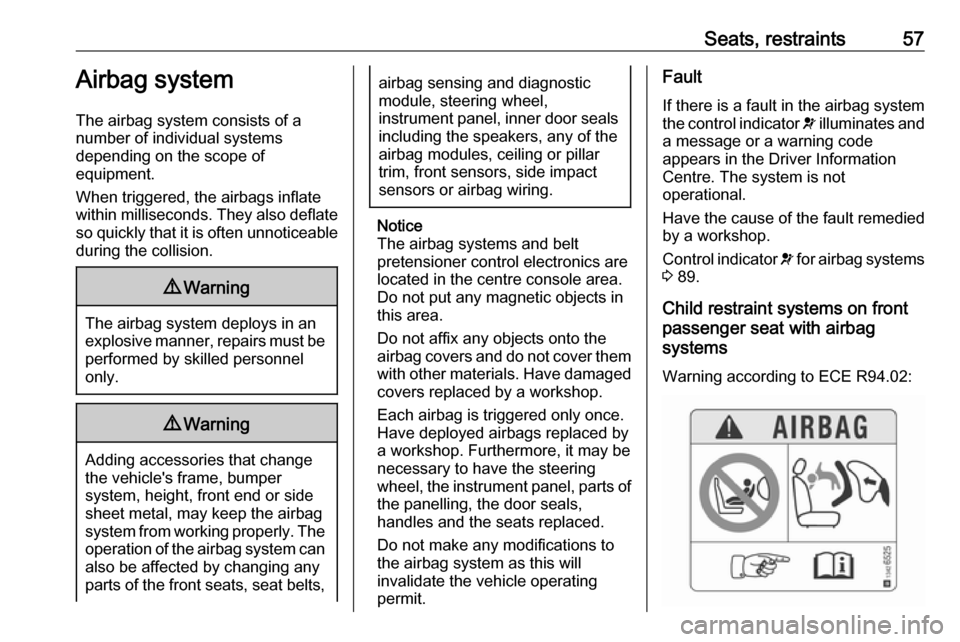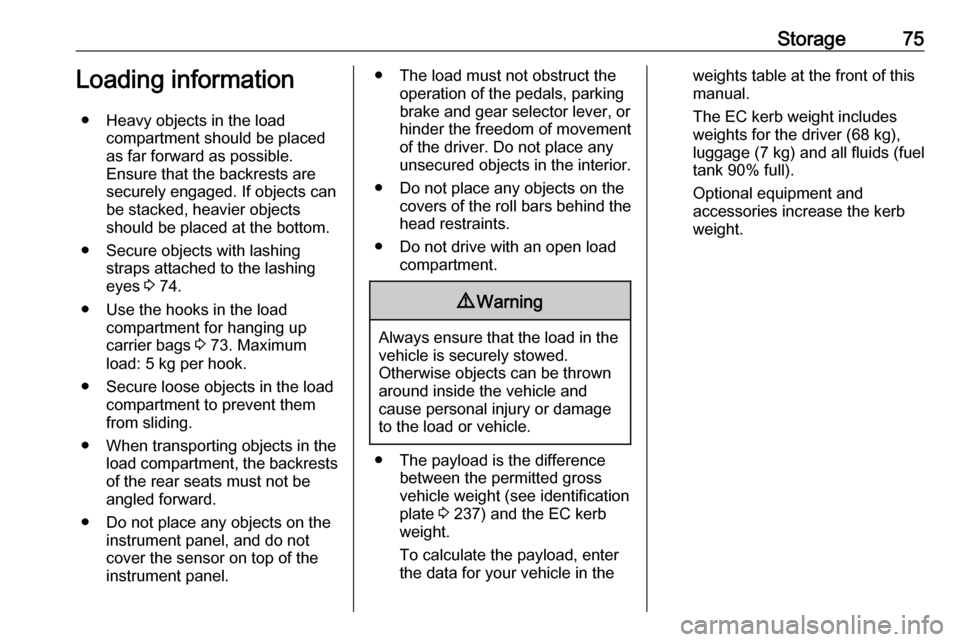warning VAUXHALL CASCADA 2018.5 Owner's Guide
[x] Cancel search | Manufacturer: VAUXHALL, Model Year: 2018.5, Model line: CASCADA, Model: VAUXHALL CASCADA 2018.5Pages: 265, PDF Size: 7.82 MB
Page 59 of 265

Seats, restraints57Airbag system
The airbag system consists of a
number of individual systems
depending on the scope of
equipment.
When triggered, the airbags inflate
within milliseconds. They also deflate
so quickly that it is often unnoticeable during the collision.9 Warning
The airbag system deploys in an
explosive manner, repairs must be performed by skilled personnel
only.
9 Warning
Adding accessories that change
the vehicle's frame, bumper
system, height, front end or side
sheet metal, may keep the airbag
system from working properly. The operation of the airbag system can
also be affected by changing any
parts of the front seats, seat belts,
airbag sensing and diagnostic
module, steering wheel,
instrument panel, inner door seals including the speakers, any of the
airbag modules, ceiling or pillar
trim, front sensors, side impact
sensors or airbag wiring.
Notice
The airbag systems and belt
pretensioner control electronics are
located in the centre console area.
Do not put any magnetic objects in
this area.
Do not affix any objects onto the
airbag covers and do not cover them with other materials. Have damagedcovers replaced by a workshop.
Each airbag is triggered only once.
Have deployed airbags replaced by
a workshop. Furthermore, it may be
necessary to have the steering
wheel, the instrument panel, parts of
the panelling, the door seals,
handles and the seats replaced.
Do not make any modifications to
the airbag system as this will
invalidate the vehicle operating
permit.
Fault
If there is a fault in the airbag system
the control indicator v illuminates and
a message or a warning code
appears in the Driver Information
Centre. The system is not
operational.
Have the cause of the fault remedied
by a workshop.
Control indicator v for airbag systems
3 89.
Child restraint systems on front
passenger seat with airbag
systems
Warning according to ECE R94.02:
Page 62 of 265

60Seats, restraintsLV: NEKĀDĀ GADĪJUMĀ
neizmantojiet uz aizmuguri vērstu
bērnu sēdeklīti sēdvietā, kas tiek
aizsargāta ar tās priekšā uzstādītu
AKTĪVU DROŠĪBAS SPILVENU, jo
pretējā gadījumā BĒRNS var gūt
SMAGAS TRAUMAS vai IET BOJĀ.
ET: ÄRGE kasutage tahapoole
suunatud lapseturvaistet istmel, mille
ees on AKTIIVSE TURVAPADJAGA
kaitstud iste, sest see võib
põhjustada LAPSE SURMA või
TÕSISE VIGASTUSE.
MT: QATT tuża trażżin għat-tfal li
jħares lejn in-naħa ta’ wara fuq sit
protett b’AIRBAG ATTIV quddiemu;
dan jista’ jikkawża l-MEWT jew
ĠRIEĦI SERJI lit-TFAL.
GA: Ná húsáid srian sábháilteachta
linbh cúil RIAMH ar shuíochán a
bhfuil mála aeir ag feidhmiú os a
chomhair. Tá baol BÁIS nó GORTÚ
DONA don PHÁISTE ag baint leis.
Beyond the warning required by
ECE R94.02, for safety reasons
never use a forward-facing child
restraint system on the passenger
seat with an active front airbag.9 Danger
Do not use a child restraint system
on the passenger seat with active
front airbag.
The airbag label is located on both
sides of the front passenger sun visor.
Airbag deactivation 3 61.
Front airbag system The front airbag system consists of
one airbag in the steering wheel and
one in the instrument panel on the
front passenger side. These can be
identified by the word AIRBAG.
Additionally, there is a warning label
on the side of the instrument panel,
visible when the front passenger door
is open, or on the front passenger sun
visor.
The front airbag system is triggered in the event of a front-end impact of a
certain severity. The ignition must be
switched on.
The inflated airbags cushion the
impact, thereby reducing the risk of
injury to the upper body and head of
the front seat occupants
considerably.
Page 63 of 265

Seats, restraints619Warning
Optimum protection is only
provided when the seat is in the
proper position.
Seat position 3 47.
Keep the area in which the airbag
inflates clear of obstructions.
Fit the seat belt correctly and
engage securely. Only then is the
airbag able to protect.
Side airbag system
The side airbag system consists of an
airbag in each front seat backrest.
This can be identified by the word
AIRBAG .
The side airbag system is triggered in the event of a side impact of a certain
severity. The ignition must be
switched on.
The inflated airbags cushion the
impact, thereby reducing the risk of
injury to the head and upper body in
the event of a side-on collision
considerably.
9 Warning
Keep the area in which the airbag
inflates clear of obstructions.
Notice
Only use protective seat covers that have been approved for the vehicle.Be careful not to cover the airbags.
Airbag deactivation
The front passenger airbag system
must be deactivated if a child restraint
system is to be fitted on this seat. The side airbags, the belt pretensioners
and all driver airbag systems will
remain active.
Page 65 of 265

Seats, restraints63Child restraints
Child restraint systems
We recommend the following child
restraint systems which are tailored
specifically to the vehicle:
● Group 0, Group 0+
Vauxhall Baby Safe, with or
without ISOFIX base, for children
up to 13 kg
● Group I
Vauxhall Duo ISOFIX, for
children from 9 kg to 18 kg
● Group II, Group III
Vauxhall Kid, for children from
15 kg up to 36 kg
When a child restraint system is being
used, pay attention to the following
usage and installation instructions
and also those supplied with the child
restraint system.
Always comply with local or national
regulations. In some countries, the
use of child restraint systems is
forbidden on certain seats.9 Warning
When using a child restraint
system on the front passenger
seat, the airbag systems for the
front passenger seat must be
deactivated; if not, the triggering of the airbags poses a risk of fatal
injury to the child.
This is especially the case if rear-
facing child restraint systems are
used on the front passenger seat.
Airbag deactivation 3 61.
Airbag label 3 57.
9 Warning
When using child restraint
systems on the rear seats, ensure that the backrests are engaged
securely in upright position.
Selecting the right system
The rear seats are the most
convenient location to fasten a child
restraint system.
Children should travel facing
rearwards in the vehicle as long as
possible. This makes sure that the child's backbone, which is still very
weak, is under less strain in the event of an accident.
Suitable are restraint systems that
comply with valid UN ECE
regulations. Check local laws and
regulations for mandatory use of child restraint systems.
Ensure that the child restraint system
to be installed is compatible with the
vehicle type.
Ensure that the mounting location of
the child restraint system within the
vehicle is correct, see following
tables.
Allow children to enter and exit the
vehicle only on the side facing away
from the traffic.
When the child restraint system is not in use, secure the seat with a seat beltor remove it from the vehicle.
Page 70 of 265

68StorageStorageStorage compartments................68
Glovebox ................................... 68
Cupholders ................................ 69
Front storage ............................. 69
Armrest storage .........................70
Centre console storage .............70
Load compartment .......................71
Rear storage .............................. 73
Rear floor storage cover ............73
Lashing eyes ............................. 74
Warning triangle ........................74
First aid kit ................................. 74
Loading information .....................75Storage compartments9Warning
Do not store heavy or sharp
objects in the storage
compartments. Otherwise, the
storage compartment lid could
open and vehicle occupants could be injured by objects being thrown
around in the event of hard
braking, a sudden change in
direction or an accident.
Glovebox
The glovebox features a pen holder,
a credit card holder, a coin holder and
an adapter for the locking wheel nuts.
Close glovebox whilst driving. It can
be locked with the vehicle key.
Page 73 of 265

Storage71Load compartment
Load compartment extension
Folding load compartment partition
To enlarge the load compartment when the soft top is closed, the load
compartment partition can be folded
in.
● Close soft top 3 34.
● Open the boot lid 3 24.
● To fold in, push the load
compartment partition at the looparea upwards to the inside.
● To fold out the load compartment
partition, pull the loop downwards to the rear. The pass-through flap
must be closed in vertical
position with the Velcro
fasteners.
During soft top operation or when it is opened, the load compartment
partition must be folded out.A warning chime sounds and a
message appears in the Driver
Information Centre if the load
compartment partition is not folded
out fully, including the pass-through
flap behind the rear seats, when operating the switch to open the softtop.
Folding rear backrests
To enlarge load compartment further
or to gain access to the wind deflector
bag, both rear backrests can be
folded down.
Page 74 of 265

72Storage9Warning
Take care when operating the
electric foldable rear seats. The seat backrest is folded with
considerable power. Risk of injury, particularly to children.
Ensure that nothing is attached to
the rear seats or located on the
seat cushion.
● Remove big wind deflector if installed 3 41.
● Press the catches and push down the head restraints 3 45.
● Pull the release switch p on one
or both sides of the load
compartment, to fold down the
backrests onto the seat cushion.
● To fold up, raise the backrest and
guide it into an upright position
until it engages audibly.Caution
When loading the vehicle from the passenger compartment, fold in
the load compartment partition.
Otherwise the load compartment
partition may be damaged.
9 Warning
When folding up, ensure that
backrests are securely locked in
position before driving. Failure to
do so may result in personal injury or damage to the load or vehicle in the event of hard braking or a
collision.
Pass-through flap behind rear seats
For transporting long objects in the
load compartment, a pass-through
flap between load compartment and
vehicle interior can be opened:
● Remove the installed big wind deflector or the bag with the
stowed wind deflectors behind
the rear seats 3 41.
● Close soft top 3 34.
● Push the load compartment partition at the loop area upwards
to the inside 3 71.
Page 76 of 265

74StorageLashing eyes
The lashing eyes are designed to
secure items against slippage, e.g.
using lashing straps or luggage net.
Warning triangle
Warning triangle is stowed in the
space on the inside of the boot lid
behind the straps.
First aid kit
The first aid kit is stowed on the right
side in the load compartment behind
a strap.
Page 77 of 265

Storage75Loading information● Heavy objects in the load compartment should be placed
as far forward as possible.
Ensure that the backrests are
securely engaged. If objects can
be stacked, heavier objects
should be placed at the bottom.
● Secure objects with lashing straps attached to the lashing
eyes 3 74.
● Use the hooks in the load compartment for hanging up
carrier bags 3 73. Maximum
load: 5 kg per hook.
● Secure loose objects in the load compartment to prevent themfrom sliding.
● When transporting objects in the load compartment, the backrestsof the rear seats must not be
angled forward.
● Do not place any objects on the instrument panel, and do not
cover the sensor on top of the
instrument panel.● The load must not obstruct the operation of the pedals, parking
brake and gear selector lever, or
hinder the freedom of movement of the driver. Do not place any
unsecured objects in the interior.
● Do not place any objects on the covers of the roll bars behind the
head restraints.
● Do not drive with an open load compartment.9Warning
Always ensure that the load in the
vehicle is securely stowed.
Otherwise objects can be thrown
around inside the vehicle and
cause personal injury or damage
to the load or vehicle.
● The payload is the difference between the permitted grossvehicle weight (see identification
plate 3 237) and the EC kerb
weight.
To calculate the payload, enter the data for your vehicle in the
weights table at the front of this
manual.
The EC kerb weight includes
weights for the driver (68 kg),
luggage (7 kg) and all fluids (fuel
tank 90% full).
Optional equipment and
accessories increase the kerb
weight.
Page 78 of 265

76Instruments and controlsInstruments and
controlsControls ....................................... 77
Steering wheel adjustment ........77
Steering wheel controls .............77
Heated steering wheel ...............77
Horn ........................................... 78
Windscreen wiper and washer ..78
Outside temperature ..................79
Clock ......................................... 80
Power outlets ............................. 81
Cigarette lighter ......................... 82
Ashtrays .................................... 82
Warning lights, gauges and indi‐ cators ........................................... 83
Instrument cluster ......................83
Speedometer ............................. 83
Odometer .................................. 83
Trip odometer ............................ 83
Tachometer ............................... 84
Fuel gauge ................................ 84
Engine coolant temperature gauge ....................................... 84
Service display .......................... 85
Control indicators ......................86
Turn lights .................................. 88Seat belt reminder.....................89
Airbag, belt tensioners and roll bars .......................................... 89
Airbag deactivation ....................89
Charging system .......................89
Malfunction indicator light ..........90
Brake and clutch system ...........90
Operate pedal ............................ 90
Electric parking brake ................90
Electric parking brake fault ........91
Antilock brake system (ABS) .....91
Upshift ....................................... 91
Power steering .......................... 91
Lane departure warning ............91
Electronic Stability Control off ...92
Electronic Stability Control and Traction Control system ...........92
Traction Control system off .......92
Preheating ................................. 92
Exhaust filter .............................. 92
AdBlue ....................................... 92
Tyre pressure monitoring system ...................................... 92
Engine oil pressure ....................93
Low fuel ..................................... 93
Immobiliser ................................ 93
Exterior light .............................. 93
High beam ................................. 93
High beam assist .......................94
Adaptive forward lighting ...........94Fog light ..................................... 94
Rear fog light ............................. 94
Cruise control ............................ 94
Vehicle detected ahead .............94
Door open .................................. 94
Displays ....................................... 94
Driver Information Centre ..........94
Info Display ................................ 99
Vehicle messages ......................101
Warning chimes .......................101
Battery voltage ........................ 102
Vehicle personalisation ..............102
Telematics service .....................107
OnStar ..................................... 107